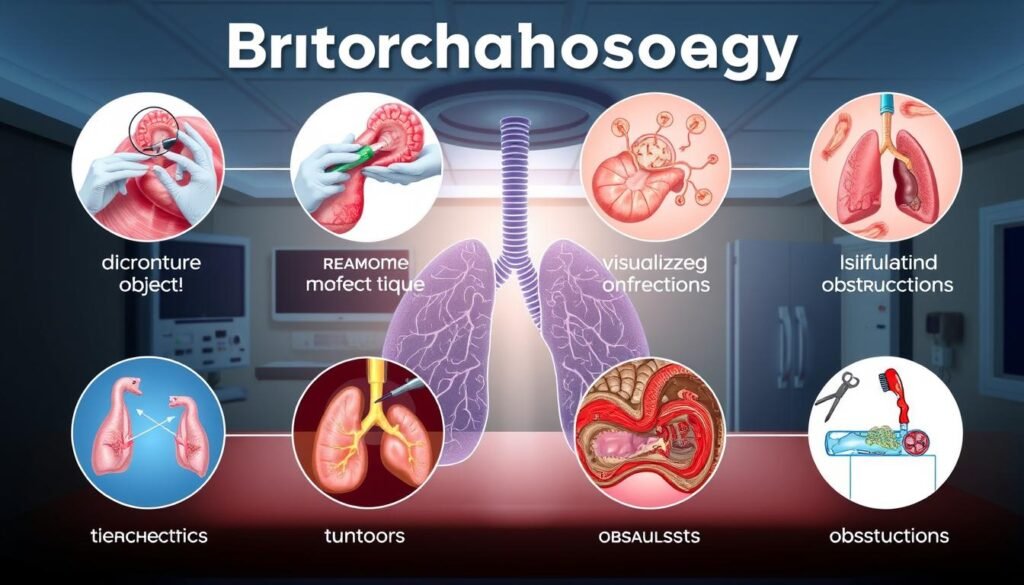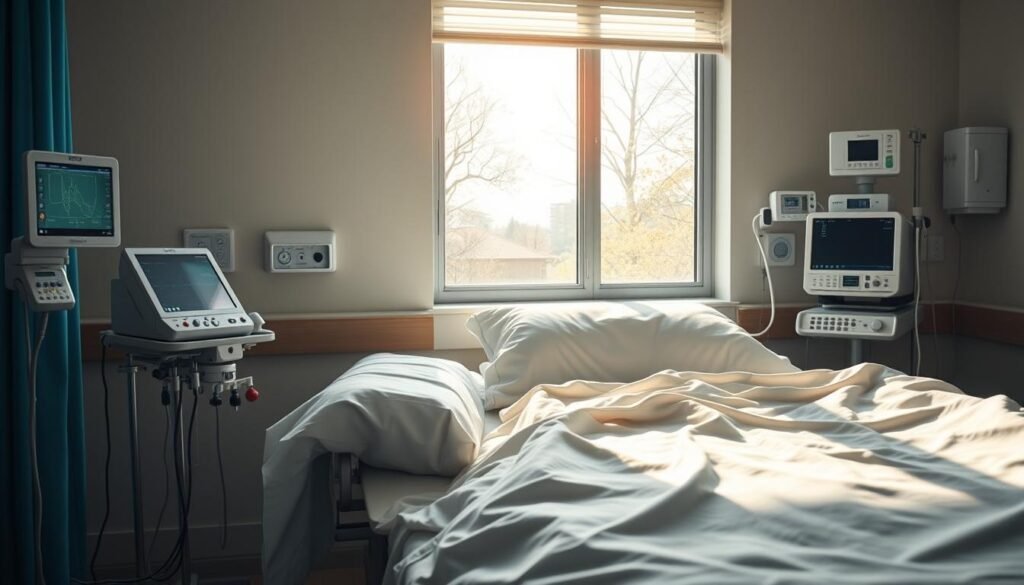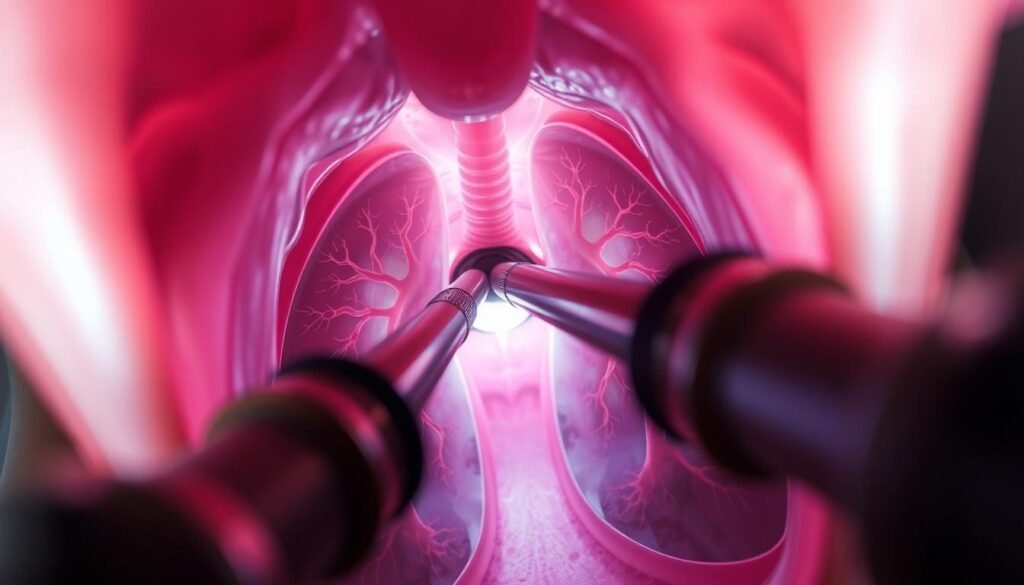Did you know a bronchoscopy usually takes 30 to 90 minutes? This vital procedure checks the lungs and airways. It’s a key part of checking lung health. In this bronchoscopy guide, you’ll learn about the procedure, the tools used, and why doctors perform it. Bronchoscopy helps find and treat lung issues, improving breathing health.
Bronchoscopes give pulmonologists a clear view into the bronchial tubes. This lets them see lung problems up close. We’ll go deep into the procedure next. That includes how to get ready, possible risks, and the latest advances. For more on bronchoscopy, see the Mayo Clinic website.
Key Takeaways
- Bronchoscopy typically lasts between 30 to 90 minutes.
- Most bronchoscopies are done without staying in the hospital.
- There are two types of bronchoscopes: rigid and flexible.
- After, you might have a sore throat or cough a bit.
- Risks like bleeding and pneumonia are rare but can happen.
- You’ll need to follow certain food and medicine rules beforehand.
- It’s important to go back to your doctor to talk about what they found.
Introduction to Bronchoscopy
Bronchoscopy is key for checking lung health. It lets doctors see inside your lungs’ airways. This helps diagnose different lung problems. A tool called a bronchoscope goes through the nose or mouth into the lungs. It gives a detailed look at the airways. This is crucial for finding problems like infections, tumors, and shape issues.
The bronchoscopy overview covers both finding and treating lung issues. Doctors suggest it for ongoing coughing, coughing up blood, wheezing, or trouble breathing. Even if it sounds scary, it’s usually safe with few risks. This makes bronchoscopy a trusted method for checking lung health.
Patients must not eat or drink for six hours before the test. This is important to make sure it goes smoothly. Usually, it’s done in a day at the hospital. The flexible tool used can also take tissue samples if needed. This shows how important and versatile bronchoscopy is in medicine today.
| Aspect | Flexible Bronchoscopy | Rigid Bronchoscopy |
|---|---|---|
| Access | Lower airways (third order bronchi) | Proximal airways only |
| Anesthesia | Conscious sedation | General anesthesia required |
| Common Uses | Diagnostic and therapeutic | Limited therapeutic options |
| Procedure Type | More widely used | Less commonly performed |
Flexible bronchoscopy is becoming more popular because it’s so effective. It really helps in diagnosing and treating lung problems. Knowing about this procedure can help us understand its big role in medicine.
What is a Bronchoscopy?
A bronchoscopy is a medical test. It lets doctors look at your lungs’ airways using a bronchoscope. This tool is a thin tube with a camera and light. It’s key in finding and treating lung problems. Learning what a bronchoscopy is and how it works helps us understand its role in health care.
Definition and Function
Bronchoscopies help find what’s causing lung issues. Things like trouble breathing, non-stop coughing, or unknown objects in the breathing paths. The doctor can take small tissue samples during it. These samples help diagnose lung diseases or infections. The whole thing usually takes 20 to 30 minutes.
Afterwards, it takes about 1 to 2 weeks to get the results. This means doctors can quickly decide how to treat the patient.
Types of Bronchoscopes
There are two major types of bronchoscopes. Each plays a unique part in patient care:
- Flexible Bronchoscope: This is the more common type. It’s versatile and can reach smaller airways. Doctors use it for both finding problems and treating them in one go.
- Rigid Bronchoscope: This one is straight and used in special cases. It helps when doctors need to take out big blockages or deal with serious airway issues.
Uses of the Bronchoscopy Procedure
Bronchoscopy is key in both finding problems and treating them. It allows experts to look inside the airways and lungs. They can find issues and give treatments right away.
Diagnostic Purposes
A diagnostic bronchoscopy helps find lung diseases. Doctors use it to:
- Spot infections and evaluate unusual chest X-rays.
- Get tissue for a lung biopsy, which is vital to confirm things like cancer.
- Look into problems like a chronic cough or mystery bleeding.
- Find objects that should not be there, especially in kids, and may need fast treatment.
Treatment Applications
Treatment bronchoscopy is about treating lung problems well. This can involve:
- Getting rid of objects stuck in the airways.
- Clearing up fluid that’s messing with lung function.
- Putting medicine right into the lungs for precise treatment.
- Using high-tech methods like Electromagnetic Navigation Bronchoscopy to sample lung masses.
For detailed info on bronchoscopy, check out Mount Sinai Health Library. Knowing more about it shows how it helps with respiratory health and patient care.
| Purpose | Description |
|---|---|
| Diagnostic | Used to identify infections, assess abnormalities, and obtain tissue samples for biopsy. |
| Treatment | Helps in removing blockages, draining fluids, and delivering medications directly to the lungs. |
Why is Bronchoscopy Done?
Bronchoscopy helps doctors look closely at your airways and lungs. It is used for many reasons, like finding lung problems, or carrying out certain treatments.
Common Indications for the Procedure
Doctors might suggest a bronchoscopy for several reasons, such as:
- Persistent cough
- Abnormal imaging results
- Suspected lung infections
- Biopsy of suspicious lung masses
The results from a bronchoscopy can help solve many lung issues. This procedure usually lasts 30-45 minutes. It allows for a detailed check-up and, if needed, quick treatments.
Situations for Urgent Bronchoscopy
In some cases, an urgent bronchoscopy may be needed. Situations include:
- Severe airway obstruction
- Significant bleeding
- Critical patient scenarios
Quick action is necessary in these situations to fix breathing problems. Patients might need extra oxygen to keep safe oxygen levels during and after the procedure. It’s important for patients to know about the benefits and risks of bronchoscopy.

| Indications | Details |
|---|---|
| Persistent cough | Lasting symptoms that require further investigation. |
| Abnormal imaging results | Screens for potential issues indicated by X-rays or CT scans. |
| Suspected lung infections | Helps identify bacteria, viruses, or other pathogens in the airways. |
| Biopsy of suspicious masses | Provides tissue samples for analysis of cancer or other conditions. |
Understanding Lung Examination and Pulmonary Evaluation
Lung exams are key to evaluating our breathing system. Bronchoscopy stands out by giving doctors a clear view inside the airways. This method is a big help in checking lung health.
Techniques like bronchoscopy work well with other tests, such as Chest X-rays and CT scans. Together, they offer a full picture of a person’s lungs. This way, doctors can spot everything from infections to obstructions.
A detailed check-up helps in making personalized care plans. Knowing the exact lung problems allows for better treatment choices. With new tech, lung tests are getting even better, leading to accurate findings and care.
Preparing for a Bronchoscopy
Getting ready for a bronchoscopy is key to making sure it goes well. Following the steps before the procedure helps avoid problems. It also makes the experience better for patients. Knowing what to do can help reduce worry about the procedure.
Pre-Procedure Instructions
Before getting a bronchoscopy, patients should follow some important steps. These include:
- Talking about your medical history and any allergies with your doctor.
- Getting detailed instructions about the procedure, like what will happen during and after.
- Keeping clean by bathing or showering before you go in.
- Not using lotions, perfumes, deodorants, or nail polish for a clean setting.
Food and Medication Restrictions
There are important rules about food and medicine before a bronchoscopy. Patients should:
- Not eat for four to eight hours before the procedure to avoid any risks.
- Stop taking certain medicines, like blood thinners, if their doctor says so.
- Make sure they have a ride home because of the anesthesia and pain medicine.
By sticking to these guidelines, patients can be safer and help their bronchoscopy go smoothly.
The Bronchoscopy Procedure: What to Expect
Getting ready for a bronchoscopy is key for those about to undergo it. It helps to know what will happen. This makes the experience less scary. The test takes about 20 to 30 minutes. However, plan to spend two hours for prep and recovery.
Procedure Overview
This test is usually done as an outpatient and uses a flexible bronchoscope. This tool lets doctors see the airways and lungs clearly. Patients are awake but sedated, which lets them talk if needed. A spray numbs the mouth and throat but might make you cough first.
Anesthesia and Sedation Process
For this procedure, you’ll get a sedative through an IV. It makes you feel relaxed. Some people might need general anesthesia if they use a rigid bronchoscope. This is often in kids. Don’t take blood thinners like aspirin for a week before. Also, don’t eat or drink for several hours beforehand.
| Aspect | Details |
|---|---|
| Typical Duration | 20-30 minutes, with a total appointment time of at least 2 hours |
| Type of Bronchoscope Used | Flexible fibre-optic bronchoscope is the most common |
| Type of Sedation | IV sedation that keeps patients conscious yet relaxed |
| Numbing Agent | Applied to the throat and mouth; may cause temporary coughing |
| Post-Procedure Care | No eating or drinking for 2 hours after the procedure |
| Accompaniment Requirement | Patients should have someone accompany them home |
After the test, patients are watched until they wake up fully. This ensures they are okay to leave. Knowing what happens during bronchoscopy gives patients confidence.
Recovery After Bronchoscopy
Recovery from bronchoscopy is key for getting back to daily life. Keeping a close eye on patients after the procedure helps keep them comfy and safe. They usually stay under watch until they’re alert again after sedation.
Post-Procedure Monitoring
Watching patients closely right after their bronchoscopy is very important. It’s normal to feel a bit off, with possible:
- Tiredness lasting 1 to 2 days
- A dry mouth for several hours
- A sore throat and a hoarse voice for a few days
Finding a little blood in saliva can happen if there was a biopsy. Following care instructions and taking meds correctly matters a lot for healing.
What to Expect in the Days Following
Patients should be gentle with themselves at first. They’re advised to:
- Avoid smoking for at least 24 hours
- Stay away from hard exercise until the doctor says it’s okay
- Stick to cold drinks and soft foods if swallowing is hard
It’s key to take pain meds as told if needed. Finishing any antibiotics, even if you feel better, is crucial too. Keeping up with doctor visits helps ensure everything’s on track.
Thankfully, big problems are rare, happening to less than 1% of folks. But, call a doctor if you’ve got a high fever, chest pain, or cough up a lot of blood. Being active about your care improves recovery, helping you feel better faster.

Risks and Complications of Bronchoscopy
Knowing about bronchoscopy risks is vital for patients. This procedure is mostly safe. But, certain risks must be known. This part explains common complications and what affects them.
Common Risks Associated with the Procedure
Bronchoscopy might cause mechanical or systemic issues. Here are some key procedure-related risks:
- Post-bronchoscopy pneumonia, seen in about 1.4% of patients, highlights the need for careful monitoring after.
- Pneumothorax, or lung collapse, is a risk, mainly for those with lung problems.
- Bleeding may happen, especially with biopsies. Studies show bleeding in 0.7% to 2% of cases.
- Tracheobronchial stenosis greatly increases post-bronchoscopy pneumonia risk, affecting over 75% of patients in a study.
- Airway spasms, heart issues, and low oxygen levels are also potential risks.
Complications after bronchoscopy range from 0.02% to 6.3%. Knowing these risks helps in better care. For more info, check out bronchoscopy risks and complications.
Using flexible bronchoscopes improves safety. They lower the chances of infections and airway damage. A thorough patient history check, looking at lung health or smoking, is crucial in risk assessment.
In the end, while risks exist, good preparation and care greatly reduce them. Proper steps before, during, and after bronchoscopy help in this.
Benefits of Bronchoscopy in Respiratory Diagnosis
Bronchoscopy is highly beneficial in diagnosing respiratory issues. It lets doctors see inside your airways in real-time. This makes diagnosing lung problems more accurate than traditional methods. People with breathing issues often choose this advanced tool for a clearer diagnosis.
It also allows for treatments directly to the lungs. This method improves how patients recover and feel about their care. Besides, bronchoscopy can take samples of lung tissue. This is important for detecting lung cancer or infections.
The procedure is quick, taking 30 to 60 minutes. Most people recover fast, mainly feeling just a sore throat. It’s also pretty safe, with rare serious complications. This safety adds to its popularity among patients and doctors.
Knowing the respiratory diagnosis advantages helps healthcare experts make better choices. Pulmonologists especially find bronchoscopy essential for treating lung issues effectively. In summary, it’s a key procedure in medicine today. It ensures accurate diagnosis and guides towards proper treatment.

| Aspect | Bronchoscopy | Endoscopy |
|---|---|---|
| Typical Duration | 30 to 60 minutes | 15 to 30 minutes |
| Tolerability | Well-tolerated | Well-tolerated |
| Recovery Time | Quick | Quick |
| Common Side Effect | Mild throat soreness | Mild throat soreness |
| Complication Rate | Uncommon | Uncommon |
| Severe Complications | Rare | Rare |
| Procedure Room Type | Clinic or hospital OR | Clinic or hospital OR |
| Preparation Requirements | Stop blood thinners, fasting for 4 to 8 hours | Varies |
Advancements in Interventional Pulmonology
Recent progress in interventional pulmonology has greatly improved bronchoscopy. New techniques have made these procedures safer, more precise, and less invasive. For instance, endobronchial ultrasound (EBUS) and electromagnetic navigation help doctors find and treat issues with great accuracy.
Thoracic ultrasound is now better at finding problems with the pleura, pneumothorax, and diaphragm function. It’s very sensitive and specific. Ultrasound of the lungs’ outer parts helps in spotting diseases like interstitial lung disease and problems with the pleura.
New ultrasound technologies, including AI, give clearer images and automatic analysis. This makes diagnosing easier and helps healthcare professionals work faster. Smaller ultrasound probes and portable devices mean better imaging in many places, even where resources are limited.
Techniques like ultrasound-guided tracheostomy let doctors see inside the body in real-time. This lowers the risk of problems. It shows how new methods in interventional pulmonology are making treatments safer.
In diagnosing lung infections and pneumonia, flexible bronchoscopy and lung biopsies are very useful. These methods have improved care, especially for people with weaker immune systems.
The RP-EBUS technique is notably effective, with up to 95% accuracy in identifying tumor invasion in the bronchial walls. When used with other imaging, it can be as good as more invasive tests like mediastinoscopy.
The growth of interventional pulmonology places it at the leading edge of lung medicine. Thanks to ongoing research, bronchoscopy continues to advance, helping doctors and patients alike.
Endobronchial Biopsy and Its Importance
An endobronchial biopsy is key in diagnosing lung problems, like lung cancer. It’s a simple method where doctors take small pieces of lung tissue for testing. These tests help decide the best treatment, showing how critical biopsies are in lung health.
What is an Endobronchial Biopsy?
This procedure can take from 30 to 90 minutes. It usually involves a tool called a bronchoscope to look inside the lungs and get tissue samples. Less than 1% of patients face complications, making it a very safe choice. Plus, doctors often use anesthesia so you’re comfortable and possibly asleep during it.
Uses for Biopsy in Lung Assessment
Doctors use biopsies to check lung health, focusing on issues like ongoing cough, unexpected weight loss, or odd scans. It takes about 3 to 5 days to review the samples for signs of infection, inflammation, or cancer. Afterward, you might have a minor cough or sore throat, but these symptoms usually go away quickly. Most people can go home the same day they get the biopsy. This speed is crucial for quick diagnosis and starting treatment. For more details on finding lung cancer early, click here.
Conclusion
Bronchoscopy is crucial in pulmonary medicine. It lets doctors thoroughly check the airway. This is key for diagnosing and treating respiratory issues. It can find infections, lung damage, or cancer, improving patient lung health.
The procedure is quick, taking about 20-30 minutes. Most people go home the same day. Its success and low risk, with a mortality rate of less than 0.1%, make it efficient. There are some risks, but the safety and technology advances of bronchoscopes, make it a reliable choice.
Knowing about bronchoscopy helps patients and healthcare workers understand its importance in respiratory health. Keeping up with its advancements is vital. It shows the need for effective respiratory checks in modern medicine.